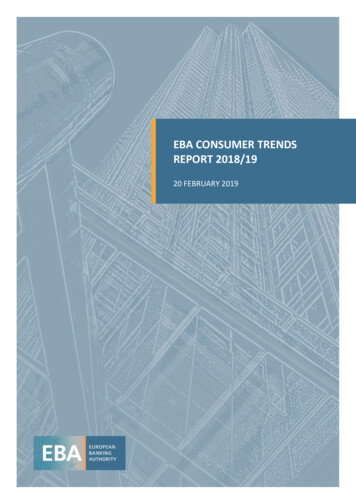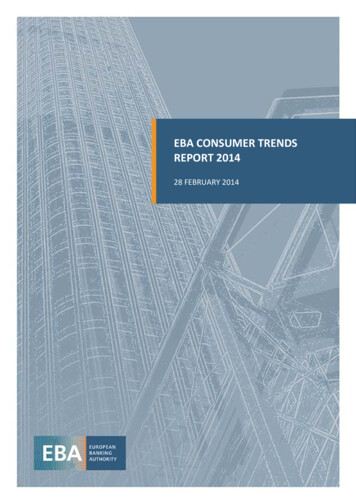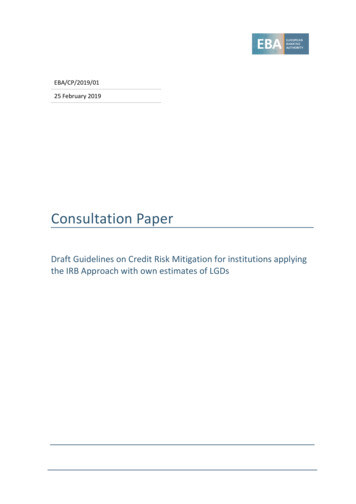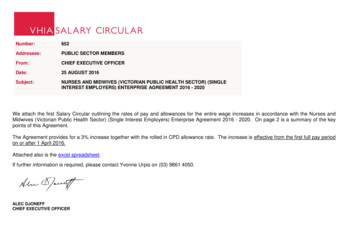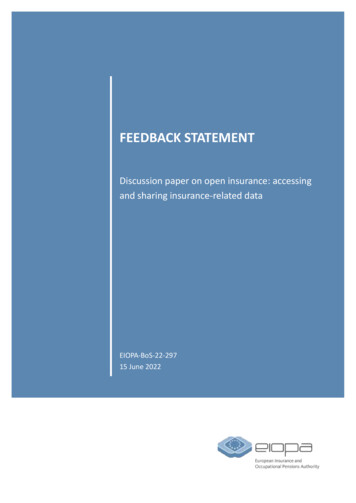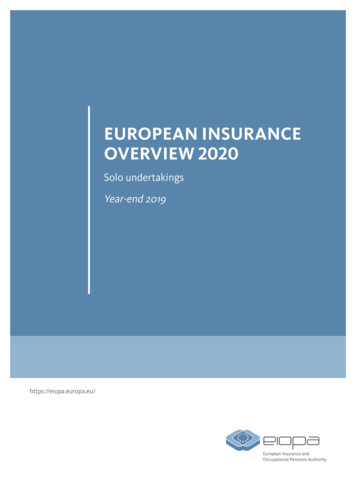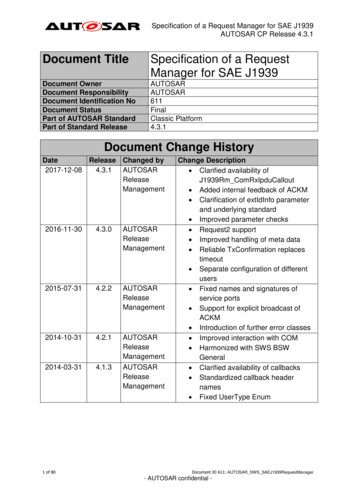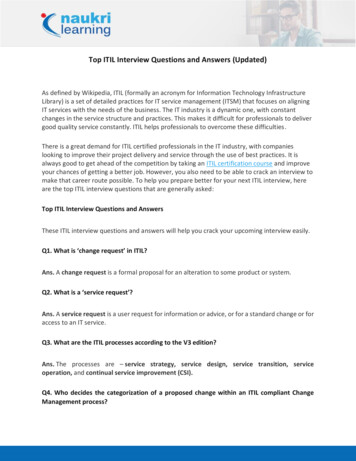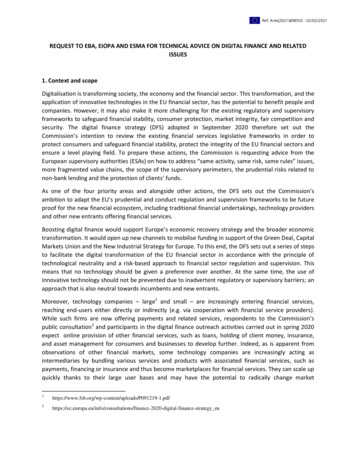
Transcription
Ref. Ares(2021)898555 - 02/02/2021REQUEST TO EBA, EIOPA AND ESMA FOR TECHNICAL ADVICE ON DIGITAL FINANCE AND RELATEDISSUES1. Context and scopeDigitalisation is transforming society, the economy and the financial sector. This transformation, and theapplication of innovative technologies in the EU financial sector, has the potential to benefit people andcompanies. However, it may also make it more challenging for the existing regulatory and supervisoryframeworks to safeguard financial stability, consumer protection, market integrity, fair competition andsecurity. The digital finance strategy (DFS) adopted in September 2020 therefore set out theCommission’s intention to review the existing financial services legislative frameworks in order toprotect consumers and safeguard financial stability, protect the integrity of the EU financial sectors andensure a level playing field. To prepare these actions, the Commission is requesting advice from theEuropean supervisory authorities (ESAs) on how to address “same activity, same risk, same rules” issues,more fragmented value chains, the scope of the supervisory perimeters, the prudential risks related tonon-bank lending and the protection of clients’ funds.As one of the four priority areas and alongside other actions, the DFS sets out the Commission’sambition to adapt the EU’s prudential and conduct regulation and supervision frameworks to be futureproof for the new financial ecosystem, including traditional financial undertakings, technology providersand other new entrants offering financial services.Boosting digital finance would support Europe’s economic recovery strategy and the broader economictransformation. It would open up new channels to mobilise funding in support of the Green Deal, CapitalMarkets Union and the New Industrial Strategy for Europe. To this end, the DFS sets out a series of stepsto facilitate the digital transformation of the EU financial sector in accordance with the principle oftechnological neutrality and a risk-based approach to financial sector regulation and supervision. Thismeans that no technology should be given a preference over another. At the same time, the use ofinnovative technology should not be prevented due to inadvertent regulatory or supervisory barriers; anapproach that is also neutral towards incumbents and new entrants.Moreover, technology companies – large1 and small – are increasingly entering financial services,reaching end-users either directly or indirectly (e.g. via cooperation with financial service providers).While such firms are now offering payments and related services, respondents to the Commission’spublic consultation2 and participants in the digital finance outreach activities carried out in spring 2020expect online provision of other financial services, such as loans, holding of client money, insurance,and asset management for consumers and businesses to develop further. Indeed, as is apparent fromobservations of other financial markets, some technology companies are increasingly acting asintermediaries by bundling various services and products with associated financial services, such aspayments, financing or insurance and thus become marketplaces for financial services. They can scale upquickly thanks to their large user bases and may have the potential to radically change finance-2020-digital-finance-strategy en
structures, something which can be efficiency and consumer-welfare enhancing but may also sometimesadversely affect competition. Notwithstanding the opportunities and benefits, preliminary evidence todate suggests that such concerns could be particularly pronounced as regards potential risks stemmingfrom large-scale lending operations by firms outside the traditional regulatory perimeter, which couldentail consumer protection as well as both micro and macro-prudential and conduct risks.Furthermore, technology is contributing to breaking up previously integrated value chains for a givenfinancial service, as incumbents and new entrants adopt new business models leveraging technologysuch as application programming interfaces (APIs) and platforms. A good example is the new ecosystemthat is emerging in payments and account information services3 as a result of the revised paymentservices directive (PSD2). Similar trends in other financial services could change or displace risks if notmanaged properly, especially if the entities involved are subject to different regulatory and supervisoryframeworks, or even unregulated, leading to challenges for supervision and risk mitigation. This could bean issue for instance where start-ups are in co-operation agreements with incumbent financialinstitutions for the technology focused development or provision of a new or improved service. Therelevance of technology firms for the financial service value chain is increasing, ranging from paymentsand banking to insurance services. Similar issues may arise in relation to the leveraging of digitalplatforms for the provision of financial (and non-financial) services.Technology companies have already become an integral part of the financial ecosystem and this trend islikely to continue. Most respondents to the consultation preceding the digital finance strategy expectrisks to increase in the event the regulatory and supervisory frameworks were not to adapt to the newbusiness models. It is important to address any risks, affecting in particular customers and consumers(policy-holders, investors and depositors) and financial stability issues while ensuring fair competition infinancial services markets and preventing the use of the EU’s financial system for money laundering andterrorist financing (ML/TF) purposes.International,4 European5 and national supervisors have assessed these market trends and theassociated opportunities, challenges and risks from various perspectives. They drew attention to issueswith competition and conduct, ML/TF risks, transparency and complaints management, operationaldependency, concentration of funds and liquidity risks, increasing systemic risks, credit and financialstability risks. The ESAs have recently carried out in-depth assessments of BigTech in finance, theincreasingly fragmented or non-integrated value chain in the insurance sector and more recently havebeen taking forward preliminary work regarding the leveraging of digital platforms6 in insurance,3Following the implementation of the PSD2, it is estimated that there are about 250 licensed TPPs and about 300 banksoffering TPP-like services across the -models-arisingdigitalisation enhttps://ec.europa.eu/eusurvey/runner/EBA digital platforms survey 20206There are different definitions of platforms. According to EIOPA, a platform is the technical infrastructure necessary formultiple participants to connect and interact with each other, and create and exchange value. According to the EBA, a digitalplatform/platform enables at least one financial institution directly (or indirectly using a regulated or unregulatedintermediary) to market to customers, and/or conclude with customers contracts for, financial products and services withinthe EEA.
banking and payments. They have also identified potential impediments to the cross-border provision ofbanking and payment services in the EU.7 These assessments will bring relevant elements in the contextof the call for advice. At the same time, the advice should capture the challenges and risks that sectoraland cross-sectoral developments bring for regulators and supervisors.Finally, it should be noted that the legislative proposal for the Digital Markets Act (DMA)8 – adopted on15 December 2020 – proposes new ex-ante rules for gatekeeper platforms as well as a new supervisoryframework at EU level to address conduct and competition harm risks. Most of the large technologycompanies which are currently offering financial services are likely to fall into the scope of this proposal.The 2020 public consultation on digital finance suggested that consumers would face new conduct riskswhich requires a new perspective from regulators. The DMA will address some of the conduct risks toconsumers posed by the significant market power of the big tech companies, but the ESAs shouldcontinue to consider other potential sources of risks. Of course, the DMA will not deal with the risksusually covered by prudential supervision either.As set out in the DFS, the Commission will, where necessary, adapt the existing conduct and prudentialEU legal frameworks so as to continue safeguarding financial stability and integrity, and protectingconsumers and other customers in line with the principles of technical/technological neutrality and“same activity, same risk, same rules”.2. ProcedureThe Commission requests the technical advice of the ESAs based on its Digital Finance Strategy, whichsets out its work for the coming four years in this domain. The Commission may propose newlegislations, amendments to existing EU legislations or take other actions. The technical advice of theESAs will be a key input to this work.The Commission reserves the right to revise and/or supplement this formal mandate.The technical advice received on the basis of this mandate will not prejudge the Commission's finaldecision in any way. In accordance with the established practice, the Commission may consult otherexperts or seek other inputs.The ESAs should consult the Joint Committee on the aspects that fall under the scope of the Committee.The European Parliament and the Council will be informed about this request, which will be available onthe website of the Directorate-General for Financial Stability, Financial Services and Capital MarketsUnion once it has been transmitted to the European Supervisory Authorities.7See in particular the EBA’s October 2019 ts/files/document and-opendigital-markets en
3. The ESAs are invited to provide technical advice on the following items3.1. Regulation and supervision of more fragmented or non-integrated value chainsAs the DFS stated, the Commission will assess how to ensure comprehensive supervision of the morefragmented value chains and the new providers of financial services. Digitalisation and technologicalinnovation can lead to more fragmented value chains in finance. Even though the use of third-partyservices and outsourcing is not new in the financial area, technological developments are increasing theextent to and ways by which financial services providers rely on third-parties in the delivery of services.This can be done through various ways, outsourcing, partnerships, cooperation agreements or jointventures.Financial services providers already cooperate closely with other financial and non-financial companiesfor the provision of a single financial service e.g. insurance undertakings with reinsurance undertakings,investment firms with clearing and settlement services providers, banks with payment service providersand payment card schemes. Further, some new market participants are cooperating with creditinstitutions in order to fulfil the safeguarding requirements set out in the respective directives.However, interconnections historically have been limited and based on relatively clear functionalseparation.Technological developments and regulatory initiatives to reduce barriers to entry for new services andproviders are changing the arrangements. For example, BigTech companies are partnering withregulated financial institutions to offer either non-financial services, such as cloud services which arenecessary in the digital context, or financial services such as payment, insurance or lending services9. Inits recent proposal on Digital Operational Resilience10, the Commission proposed to establish anoversight framework for critical third-party providers which are intended to address the risks stemmingfrom this cooperation with these companies when offering cloud services providers to the financialindustry. However, this framework does not address all the challenges and especially the prudentialrisks linked to the offering of financial services by BigTech companies.In recent years, open banking – the opening up of the market for payment services to competition bybank clients granting companies access to their payment account information – has also triggered thedevelopment of innovative payment services requiring the cooperation of account servicing paymentservice providers and third-party providers (providing payment initiation and account informationservices). PSD2 has opened up the market for payment service providers (including those leveraginginnovative business models) and required banks to cooperate with them. When initiating paymenttransactions, customers may use an app operated by a payment initiation provider but the transaction isexecuted by the account servicing payment service provider (often a bank). This way the serviceprovision is based on more than one regulated payment service provider that are legally andeconomically separated. They need to operationally work together smoothly to ensure the quality andthe security of the financial services. In the insurance sector, InsurTech companies are increasingly9Apple and Goldman Sachs partnered to offer a credit card; Google recently announced new partnerships with banks andcredit unions in the US. Also in insurance, especially outside the EU. See e.g. 4-digital-finance-proposals en
partnering with insurers to offer new and more innovative services to customers, as set out by EIOPA inits recent Discussion Paper on the (re)insurance value chain11. These trends go beyond payments andinsurance though, as similar issues arise from increasing reliance on third party service tech providers(e.g. technological systems, cloud, AI algorithms, etc.).The joint provision of a single financial service by several specialised entities may lead to greaterefficiency and overall benefits to the users of financial services. It could however also create new risks asthe provision of a service is divided into parts, each executed by a separate entity which may be subjectto different legal requirements. The existing regulatory framework may currently not sufficiently takeinto account such collaborative business models. However, it must be ensured that the appropriaterequirements are followed by each actor within the chain of service providers, who jointly provide theservice. The framework should also ensure that the requirements for each provider of the value chainare proportionate to the risks that they may create and that it is clear which actor maintains liability indifferent scenarios.In the context of cross-border supervision, the multiple cooperating actors can also raise issues andquestions about coordination between different supervisors involved, and about the legal responsibilityfor conduct, operational resilience of the entire value chain, and prudential treatment. For example,with multiple actors, including non-regulated technology companies, the consumer may need clarity onwho is effectively responsible for providing the service and where to request information from, reportproblems to and request remedies from. Similarly, authorities also need clarity on the legalresponsibilities of the various businesses and thus where they need to intervene.Request to the ESAs:The ESAs should in their respective areas monitor and if warranted report on new materialdevelopments in the evolution and fragmentation of value chains of single financial services driven bytechnological innovation and the entry of new market participants. The ESAs are requested to assess ifand when more fragmented or non-integrated12 value chains lead to unidentified or unaddressed risks interms of notably financial stability, market integrity or consumer protection and what challenges theybring for supervisors. They should, if and when warranted, advise how to manage the overall risks of thevalue chain and in particular advise on how to ensure a holistic approach to regulation and supervision.The advice should pay particular attention to regulatory and supervisory challenges (prudential,AML/CFT and conduct) stemming from (i) cooperation among regulated providers active in multiplesubsectors of financial services (e.g. retail financial services, payments, investment services, insurance)and established in one or various Member States in the EU, (ii) cooperation between technologycompanies – in particular BigTech firms – and financial service providers established in one or variousMember States in the EU, (iii) cooperation among multiple subsectors of financial services and nonregulated companies operating in the EU but established outside the els-arisingdigitalisation en12I.e. value chains that are not entirely controlled by the same economic entity.
3.2 Platforms and bundling of various financial servicesPlatforms can market or provide access to multiple financial services, often from various serviceproviders such as payments services, payment accounts, lending, investment, and insurance products.Financial services providers operating digital distribution channels can also cooperate with new fintechcompanies to bundle a range of financial services. These service providers may form part of the samecompany or group as the platform provider or be provided by third parties which may or may not belongto the same corporate group and potentially be licenced in different Member States or outside of theEU. The different financial services bundled on the platform may fall under separate sectorialregulations and supervisory arrangements, or may potentially fall outside of the scope of the EUfinancial services regulatory perimeter, as may be the case for some lending activities (see section 4.1).The traditional regulation and supervision of financial services are sector-based and often have a singlefocus, e.g. banking, insurance, investment services. Hence, currently, the supervision of the variousservices marketed or offered together may be conducted by multiple national and EU supervisoryauthorities. The platforms are not typically subject to any holistic regulation nor supervised in a holisticway. However, they could pose a compound risk with the bundled products as regards e.g. interactionwith consumer and customer protection, conduct of business, ML/TF risk, operational risk etc. Thiscompound risk might not be captured fully or adequately by the current regulatory or supervisory setuplargely based on sectoral lines.Request to ESAsThe ESAs are requested to assess the extent to which platforms that operate across multiple MemberStates to market or provide various financial products and services are effectively regulated andsupervised. Keeping in mind broader Commission policy objectives, such as the creation of a CapitalMarkets Union, they should advise whether there is a need to extend or modify current EU financialservices regulation and whether there is a need to enhance supervisory practices, including throughconvergence measures. The ESAs should take into account the supervisory perimeters of the legislationalready in force or already adopted (e.g. Regulation on European Crowdfunding Service Providers, ECSP).They should also assess if current supervisory capacities and skill are adequate for monitoring suchonline services and enforcing rules and provide such advice as appropriate.3.3. Risks of groups combining different activitiesSectoral legislations have been developed to manage the specific risks that each financial sector andactivity represents. For example, stringent regulations are justified when it comes to risks related todeposit taking activities. In these cases, in addition to the solo supervision of the individual banks in agroup, supervision on a consolidated basis is also required, so that the risks of the entire banking group,i.e. including all relevant financial institutions within that group, are duly taken into account for thepurposes of the prudential supervision. However, with respect to banking rules, the currentconsolidation perimeter does not include technology companies for instance when they are notconsidered as financial institutions or specific ancillary services undertakings. This may lead to i) unlevelplaying field and ii) unaddressed risks and supervision gaps that could become more important in thecontext of technological innovation.
In terms of level playing field concerns, under current rules, specific entities belonging to a bankinggroup may face different requirements than those operating outside such a group due to the particularlystrong policy imperative of ensuring the safety and soundness of banking groups and the bankingsystem. Technology companies can provide financial services and compete with banking groups withoutthe additional requirements coming from the consolidation rules. It needs to be analysed if this givesrise to level playing field issues and, if so, how these could be addressed.In terms of the risk of mixed activity groups, large technology companies active in various sectors (e.g.social media, e-commerce, transport) may increasingly enter financial services, including by establishingtheir own subsidiaries for the provision of financial services. This can pose new challenges for regulatorsand supervisors.First, large technology companies have significant capacity to quickly scale up the offerings of theirfinancial services and may pose additional risks compared to small operators without such capacity. Thismay need to be addressed by adjusting EU legislation.13Second, large technology companies offer a wide range of services and have elevated intra-groupdependencies, for instance on integrated data pools, operating systems and processes, and customeraccess. They may use their vast amount of customers’ data to support the provision of financial servicesgiving rise to questions about conduct and prudential risk management, which have not been present sofar in traditional mixed activity groups. These taken together suggest that they pose risks of a moresystemic dimension. Hence a holistic approach to their supervision may be necessary.14Existing sectoral financial legislation (banking, investment services, insurance) embed already anapproach for group supervision. On top of those, the financial conglomerates directive (FICOD) requiresa supplementary supervision aimed at identifying and addressing risks of groups that provide differentfinancial services. Those frameworks also partly tackle the issue of financial and non-financial services(with mixed financial groups and mixed activity groups requirements). However, emerging types ofmixed activity groups are not covered by a framework that facilitates coordinated supervision on across-sectoral basis, as their financial activities usually represent only a limited share of their totalbalance sheet or may only have a limited number of entities identified as financial undertakings in scopeof the prudential sectoral rules. Even when the group has a specialised financial subgroup, sectoralfinancial legislations would only apply to that subgroup, with limited possibility to supervise and preventrisks stemming from the interactions between that financial sub-group and the broader group.Furthermore, groups’ prudential supervision requirements are mainly focused on addressing group-levelcapital adequacy, risk concentration, intra-group transactions, internal control mechanisms and riskmanagement procedures. Additionally, they only scope-in ‘regulated entities’ within the financial group.Finally, the ‘competent authorities’ participating in supervision are limited to the authoritiesempowered to supervise (from a prudential perspective) ‘regulated entities’ in the group. This means13In one specific case, for example, relating to asset-referenced tokens regulated under MICA, the Commission has proposedadditional, more stringent requirements for significant operators. This approach of imposing more stringent requirements onlarger firms that may pose risks to the EU financial system as whole builds on similar approaches in regulation andsupervision of other financial firms (e.g. significant banks under CRD/CRR and significant investment firms under ract id 3693870BigTechandBeyond,ElisabethNoble:
that supervisory blind spots might exist, because (i) some types of risk might not be (or not sufficiently)reflected in EU legislations, (ii) competent authorities may lack supervisory powers in relation topotentially significant non-financial companies of the groups they supervise, and (iii) the focus ofprudential supervision might be too narrow when considered in the context of wider policydevelopments.15Request to the ESAs:In terms of level playing field, the EBA should assess (i) whether current approaches to group regulationand consolidated supervision that aim to address the risks of regulated financial groups at consolidatedlevel could be detrimental to a level playing field between entities providing the same financial servicesas part of a group versus as a single entity, and (ii) whether there are areas where targeted adjustmentsto the EU regime could be considered without endangering prudential soundness and safety. Whilethese issues have predominantly been raised in banking, the ESAs should assess the situation in othersectors such as investment firms and insurance groups, and more generally mixed activity groups goingthrough digital transformation. They should also advice on the potential need for adjusting theassociated legislations.In terms of mixed activity groups, first, the ESAs are requested to analyse new emerging risks in relationto mixed-activity groups, in particular large technology companies with a significant activity outside thefinancial sector marketing or providing financial services. The ESAs are requested to assess whethercurrent licencing practices and regulatory requirements are adequate for large mixed activity operatorsthat gain significant market share or have particular business models in payments, lending, holdingcustomer funds, and/or insurance and investment or whether these providers should be required tofulfil more stringent and proportionate requirements. The ESAs should also assess whether existing EUlegislation address these risks, or whether adjustments would be needed.Second, the ESAs are requested to analyse the potential need for a new cooperation and coordinationarrangements between financial supervisors and if needed other (data, competition) authorities in orderto ensure effective supervision of emerging new types of mixed activity groups. The ESAs are requestedto advise, where warranted, on how to adjust the supervisory arrangements relative to mixed activitygroups, in particular large technology companies that build up substantial market share in financialservices. The advice should also focus on (i) whether large technology companies (with substantialmarket share) in financial services as mixed activity groups should be supervised specifically; (ii) howinterdependencies with, and potential risks stemming from, the financial and non-financial part of thebusiness can be identified and addressed; and, (iii) how supervisory cooperation within the EU and withthird countries can be improved for these companies and groups.15The Next Generation of Financial Conglomerates: BigTech and Beyond, Elisabeth Noble
4 Additional requests for technical advice from the EBA4.1 Non-bank lendingIn accordance with the DFS, the Commission is considering the need for legislative proposals to addresspotential micro and macro-prudential risks stemming from potential large-scale lending operations byfirms outside the EU-financial services regulatory perimeter. Credit intermediation by companies thatare non-banks is not a new phenomenon; it has been on the radar screen of regulators for many years.16These entities may include financial leasing, factoring, mortgage lending and consumer lendingcompanies or other types of undertakings, also depending on Member States’ national rules andframeworks. While these activities are mostly carried out within their local markets, there is increasingevidence that the use of innovative technologies to reach new customers, including potentially crossborder, is putting pressure on traditional local models.17 At the same time, the absence of a common EUframework for such activities may be holding back a source of cross-border credit provision, which couldhelp support the recovery of the economy. As not all Members States regulate non-bank lending activityat national level and for all forms of credit provision, and where they do requirements may vary, thisleads to differential treatment across Member States.New digital means to market and provide access to products and services can make it easier for firms toreach new customers locally and cross-border. Existing firms and new market entrants, such as ecommerce platforms, telecommunication firms and other large technology companies or other entitieswhose main activity is not currently the provision of financial services, may seek to use their competitiveadvantages of a wide us
public consultation2 and participants in the digital finance outreach activities carried out in spring 2020 expect online provision of other financial services, such as loans, holding of client money, insurance, and asset management for consumers and businesses to develop further. Indeed, as is apparent from
